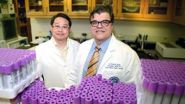(Press-News.org) The realisation of quantum networks is one of the major challenges of modern physics. Now, new research shows how high-quality photons can be generated from 'solid-state' chips, bringing us closer to the quantum 'internet'.
The number of transistors on a microprocessor continues to double every two years, amazingly holding firm to a prediction by Intel co-founder Gordon Moore almost 50 years ago.
If this is to continue, conceptual and technical advances harnessing the power of quantum mechanics in microchips will need to be investigated within the next decade. Developing a distributed quantum network is one promising direction pursued by many researchers today.
A variety of solid-state systems are currently being investigated as candidates for quantum bits of information, or qubits, as well as a number of approaches to quantum computing protocols, and the race is on for identifying the best combination. One such qubit, a quantum dot, is made of semiconductor nanocrystals embedded in a chip and can be controlled electro-optically.
Single photons will form an integral part of distributed quantum networks as flying qubits. First, they are the natural choice for quantum communication, as they carry information quickly and reliably across long distances. Second, they can take part in quantum logic operations, provided all the photons taking part are identical.
Unfortunately, the quality of photons generated from solid-state qubits, including quantum dots, can be low due to decoherence mechanisms within the materials. With each emitted photon being distinct from the others, developing a quantum photonic network faces a major roadblock.
Now, researchers from the Cavendish Laboratory at Cambridge University have implemented a novel technique to generate single photons with tailored properties from solid-state devices that are identical in quality to lasers. Their research is published today in the journal Nature Communications.
As their photon source, the researchers built a semiconductor Schottky diode device containing individually addressable quantum dots. The transitions of quantum dots were used to generate single photons via resonance fluorescence – a technique demonstrated previously by the same team.
Under weak excitation, also known as the Heitler regime, the main contribution to photon generation is through elastic scattering. By operating in this way, photon decoherence can be avoided altogether. The researchers were able to quantify how similar these photons are to lasers in terms of coherence and waveform – it turned out they were identical.
"Our research has added the concepts of coherent photon shaping and generation to the toolbox of solid-state quantum photonics," said Dr Mete Atature from the Department of Physics, who led the research.
"We are now achieving a high-rate of single photons which are identical in quality to lasers with the further advantage of coherently programmable waveform - a significant paradigm shift to the conventional single photon generation via spontaneous decay."
There are already protocols proposed for quantum computing and communication which rely on this photon generation scheme, and this work can be extended to other single photon sources as well, such as single molecules, colour centres in diamond and nanowires.
"We are at the dawn of quantum-enabled technologies, and quantum computing is one of many thrilling possibilities," added Atature.
"Our results in particular suggest that multiple distant qubits in a distributed quantum network can share a highly coherent and programmable photonic interconnect that is liberated from the detrimental properties of the chips. Consequently, the ability to generate quantum entanglement and perform quantum teleportation between distant quantum-dot spin qubits with very high fidelity is now only a matter of time."
INFORMATION:
For more information, please contact Dr Mete Atature on +44 (0)7874996463 or ma424@cam.ac.uk
Laser-like photons signal major step towards quantum 'Internet'
2013-03-19
ELSE PRESS RELEASES FROM THIS DATE:
Tenfold boost in ability to pinpoint proteins in cancer cells
2013-03-19
Better diagnosis and treatment of cancer could hinge on the ability to better understand a single cell at its molecular level. New research offers a more comprehensive way of analyzing one cell's unique behavior, using an array of colors to show patterns that could indicate why a cell will or won't become cancerous.
A University of Washington team has developed a new method for color-coding cells that allows them to illuminate 100 biomarkers, a ten-time increase from the current research standard, to help analyze individual cells from cultures or tissue biopsies. The ...
How proteins read meta DNA code
2013-03-19
Three-quarters of the DNA in evolved organisms is wrapped around proteins, forming the basic unit of DNA packaging called nucleosomes, like a thread around a spool. The problem lies in understanding how DNA can then be read by such proteins. Now, Arman Fathizadeh, a physicist at Sharif University of Technology in Tehran, Iran, and colleagues have created a model showing how proteins move along DNA, in a paper just published in EPJ E.
The problem is that until now, we did not clearly understand the physical mechanisms of how to "open the book" to read the genetic text ...
Tiny RNA molecule may have role in polycystic ovary syndrome, insulin resistance
2013-03-19
AUGUSTA, Ga. – A group of tiny RNA molecules with a big role in regulating gene expression also appear to have a role in causing insulin resistance in woman with polycystic ovary syndrome and, perhaps, in all women, researchers report.
Research in the journal Diabetes, indicates that high activity levels of a microRNA called miR-93 in fat cells impedes insulin's use of glucose, contributing to PCOS as well as insulin resistance, said Dr. Ricardo Azziz, reproductive endocrinologist and PCOS expert at the Medical College of Georgia at Georgia Regents University.
"This ...
Electrical signals dictate optical properties
2013-03-19
Researchers at the University of Southampton's Optoelectronics Research Centre (ORC) have created an artificial material, a metamaterial, with optical properties that can be controlled by electric signals.
Photonic metamaterials are artificial materials created by precise and extremely fine structuring of conventional media using nanotechnology. They offer numerous new applications from cloaking to radically improved solar cells. However, the properties of metamaterials are usually fixed.
Dr Eric Plum, Research Lecturer at the ORC, explains: "We have found a fast ...
Military personnel return to duty following severe injury to the lower extremity
2013-03-19
CHICAGO – High-energy lower-extremity trauma (HELET) is common in modern warfare, often resulting in severe tissue damage, chronic pain, neurovascular injury and significant muscle loss, according to the new research presented today at the 2013 Annual Meeting of the American Academy of Orthopaedic Surgeons (AAOS).
The Return to Run (RTR) program is an integrated orthotic and rehabilitation initiative designed to return high-level function to wounded warriors. It includes use of the new Intrepid Dynamic Exoskeletal Orthosis (IDEO), a custom-fit device made from carbon ...
Zoledronic acid does not prevent bone metastases in high-risk PCa patients
2013-03-19
Milan, 19 March 2013 - The initial study results of the Zometa European Study (ZEUS) showed no difference in the incidence of bone metastases between the Zometa group and control arm, said Prof. Manfred Wirth during the closing and fourth plenary session of the 28th Annual EAU Congress which ends today.
"There is no difference in the incidence of bone metastases and there is no difference in survival," said Wirth in his brief presentation on whether Zometa can prevent bone metastases in high risk, metastatic prostate cancer patients. The ZEUS study, supported by the EAU ...
Risk management in fish: How cichlids prevent their young from being eaten
2013-03-19
The phenomenon of adoption has taxed the minds of evolutionary scientists since Darwin first came up with his account of natural selection. According to Richard Dawkins's description, adoption is "a double whammy. Not only do you reduce, or at least fail to increase, your own reproductive success, but you improve someone else's." So why are animals apparently so willing to take care of young that are not related to them?
Franziska Schaedelin and colleagues at the Konrad Lorenz Institute of the University of Veterinary Medicine, Vienna now shed interesting light on the ...
Genetic testing may be used to identify BPH patients with increased risk of prostate cancer
2013-03-19
Milan, 19 March 2013 – Patients with benign prostatic hyperplasia (BPH) carrying prostate cancer (PCa) a risk alleles are a potential target population for PCa screening and follow-up, according to a study, which was presented yesterday at the 28th Annual EAU Congress in Milan.
The study aimed to evaluate the genetic predisposition of patients with BPH to developing prostate cancer, with findings suggesting that genetic testing may offer a new tool to identify BPH patients with increased risk to develop PrCa.
"To our knowledge this is the first study to evaluate genetic ...
Study points to risk factors of mesh-related complications in prolapse surgery patients
2013-03-19
This retrospective multicenter study, which included 677 patients from 6 centres, aimed to evaluate intraoperative, early postoperative and mesh-related complications for surgical management of female pelvic organ prolapse (POP) with application of trocar guided transvaginal synthetic mesh.
In the course of the study the patients underwent POP surgery from 2006 to 2010. The patients were operated for symptomatic genital prolapse POP-Q stage 2 to 4. Patients were systematically seen within 1 and 3 months and then evaluated again during the study via phone interview and ...
Most men with erectile dysfunction remain untreated, say US scientists
2013-03-19
Milan, 19 March 2013 - Despite the high erectile dysfunction (ED) prevalence most patients receive no treatment, according to a new US study, presented at the 28th Annual EAU Congress. Undertreatment of ED continues to be common, even though the treatments have a proven efficacy and quality of life impact.
"Until now, research conducted on the treatment of erectile dysfunction has been derived from surveys involving small populations," wrote the authors.
"However, a comprehensive and larger patient-based study using claims data that characterises men undergoing treatment ...


